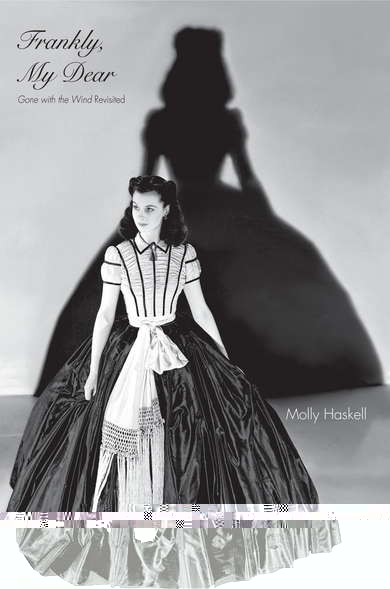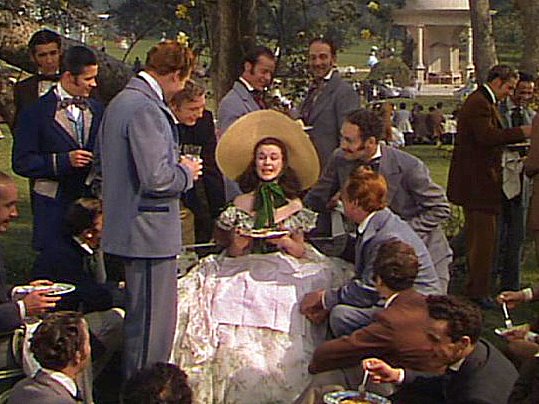
Film scholar Molly Haskell could not have been a more perfect choice for Yale University Press to tap for another volume in its Icons of America series that explicates the phenomenon -- both novel and film -- of Gone with the Wind. Its virtues and flaws are explored with an erudite, yet fresh perspective from a feminist who considers aesthetics before politics in her role as film critic. However, in Frankly, My Dear: Gone with the Wind Revisited, Haskell draws from France's vanguard social theorist Alexis de Tocqueville as well the visual artistry of Hollywood's William Cameron Menzies in analyzing the wonder of GWTW.
The author -- a transplanted southerner raised in Richmond who now lives in NYC -- never turns away from the fact that Margaret Mitchell's story trivializes the enormous human tragedy of slavery, yet elevates Mammy, a slave, to a position of wisdom who often serves as the saga's moral center. These fascinating dualities and ironies fuel the power of GWTW and Haskell's book itself. Exhaustive dichotomies in which Haskell poses Cukor next to Fleming, the delicate alongside the bold, the fussy with the sweeping -- essentially every "yin and yang" firing up the strands of GWTW's DNA -- are explored.
Haskell also posits that the irrepressible vitality and enduring fascination with GWTW is to be found in the tempestuous personalities of the maverick author Margaret Mitchell, obsessive producer David O. Selznick, and beguiling actress Vivien Leigh. One of the many uncanny circumstances surrounding the film is that Leigh -- underrated in her native England because of her stunning looks and overshadowed by her marriage to Laurence Olivier--has been immortalized for playing two of America's most famous Southern belles: Scarlett O'Hara and Blanche DuBois and won Oscars for both. "Leigh mastered the Southern accent in a matter of days," writes Haskell, "as if it had been an alternate personality waiting to emerge..."

Frankly My Dear also reflects the author's elegant economy. The 228-page book does not overlook the creative contributions of Hattie McDaniel, Olivia de Havilland, Clark Gable, Irene Mayer Selznick (who would go on to produce A Streetcar Named Desire on Broadway), Sidney Howard (the credited screenwriter), F. Scott Fitzgerald (one of many writers to work on the script), Sam Wood (like Cukor, an uncredited director), Laura Hope Crews (Aunt Pittypat), Thomas Mitchell (best supporting actor Oscar winner not for GWTW, but Stagecoach underscoring what a seminal year in film 1939 was), and Kay Brown (Selznick's crackerjack assistant) among many others.
Irony is revealed in the allure of a selfish and bratty, yet enterprising (in a man's world) and rebellious (towards her female elders) Scarlett for adolescent girls beginning in the 1930s and the use of an American novel about the civil war to inspire hope in 1978 for political prisoners in Ethiopia for whom survival was uncertain.
...a contraband copy fell into the hands of a chemistry student, an activist named Nebiy Mekonnen, who began reading the book and translating it into Amharic for his fellow inmates...fifty men squeezed into a tiny square cell and with no books allowed, the prisoners lived for the daily reading of installments of Margaret Mitchell's story.
Frankly, My Dear was released in paperback just before the author introduced the movie at the Film Forum in March. In her subtle Richmond, Virginia cadence, Haskell enchanted the audience with anecdotes: her discovery that GWTW has its version of Star Trek's "Trekkies" known as "Windies" caught up in naive notions of the past; and that her husband, scholarly film auteurist Andrew Sarris, was perhaps equally obsessed due to his fascination with "Vivien Leigh's amazing green eyes," which prompted him to see the film dozens of times.
Being open to examining the film and the novel more closely is a journey which requires an exploration of nation and of self, from which the author never shies away. Haskell inscribes Frankly, My Dear with psychoanalytic insight, hermeneutic precision, and cinephilic verve.
This article was originally published in Critical Women on Film the journal of the Women Film Critics Circle.